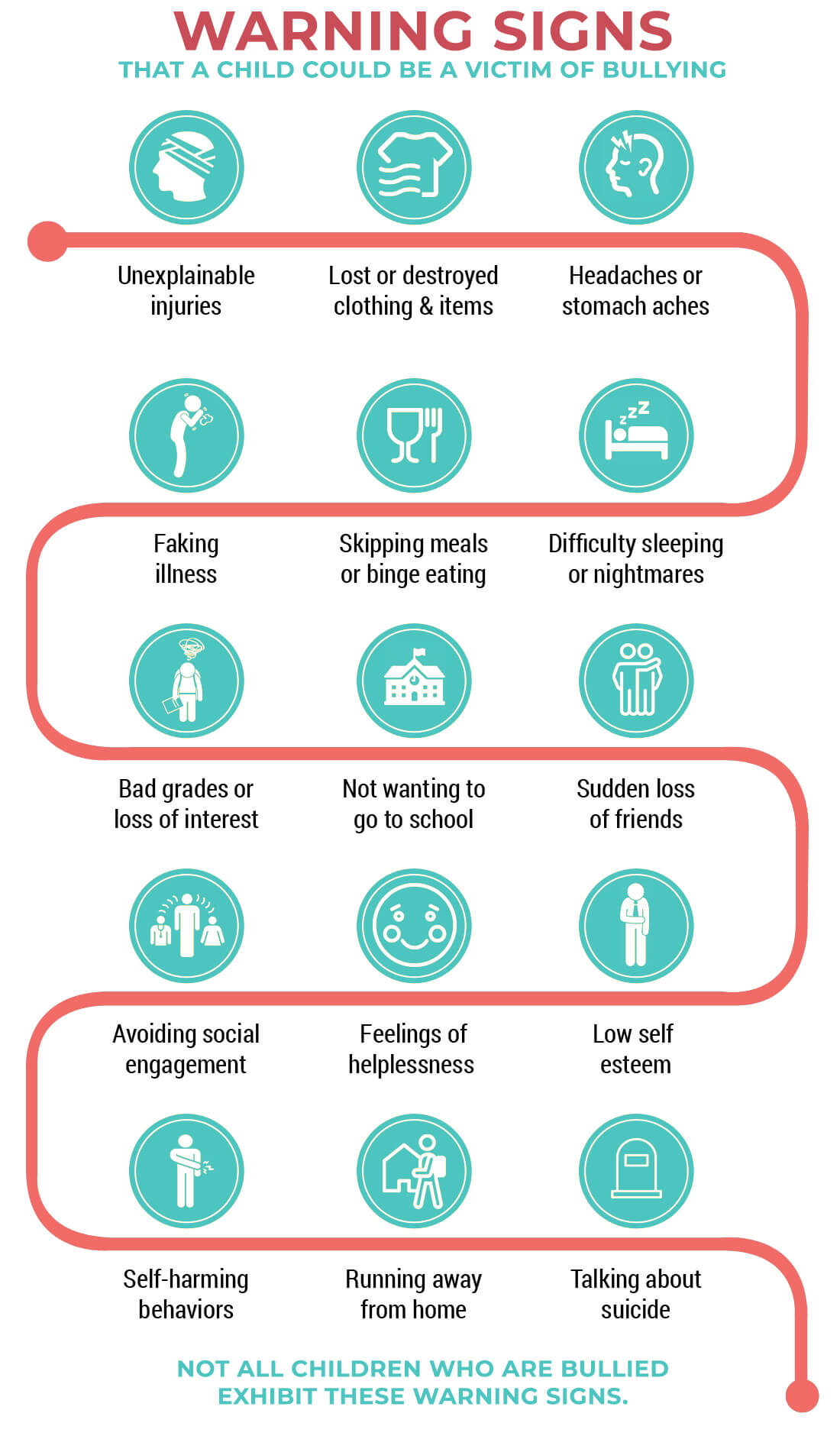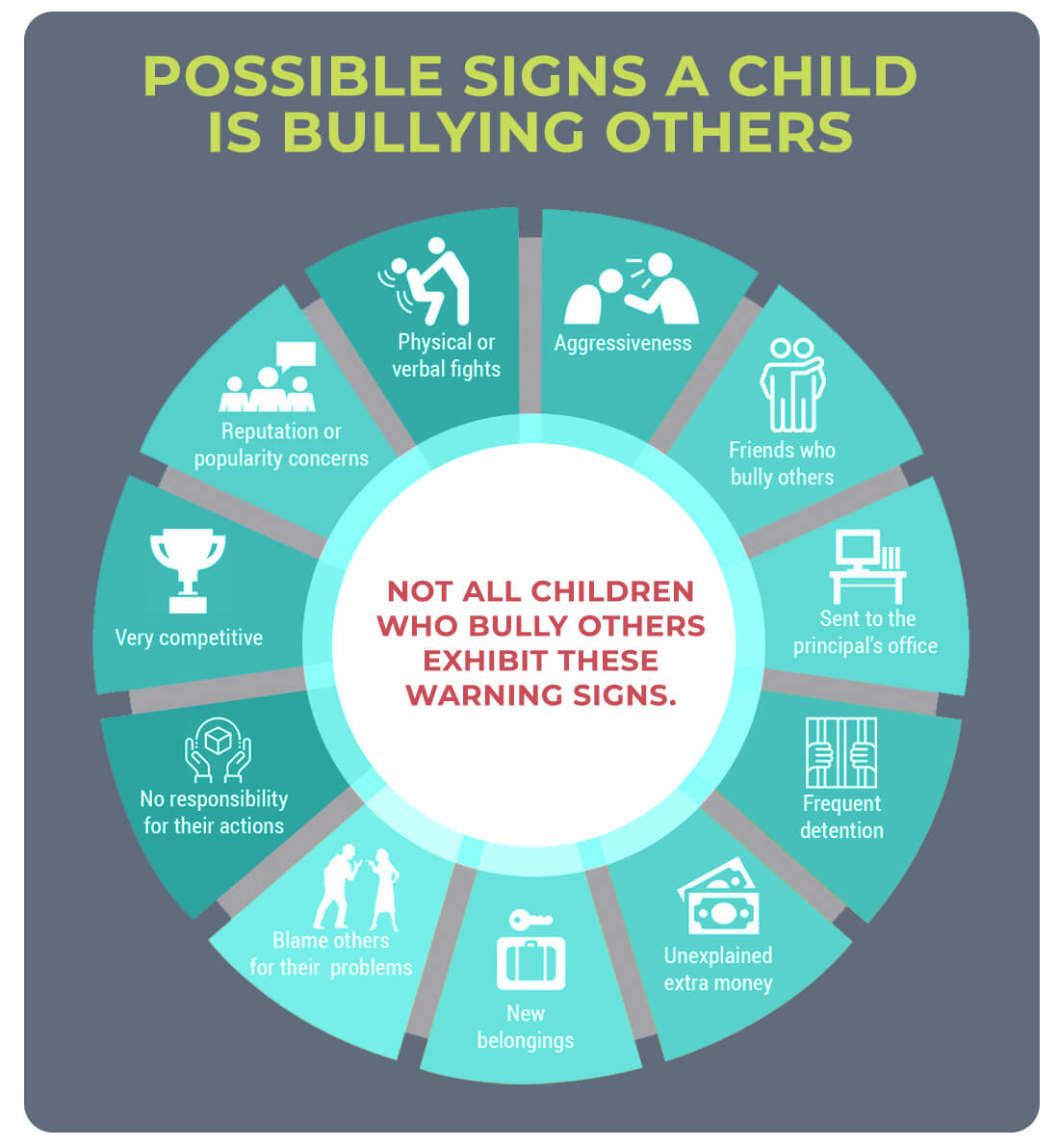Bullying: Learn the Signs
Child abuse needs to stop and education is the key.
The following free resources are essential to driving change and
are made possible through your contributions. Thank you.

See The Warning Signs
If you notice your child is the target of bullying and appears anxious, sad, or ill, has difficulty sleeping, or exhibits other worrisome behaviors, talk to your child openly, or contact his or her doctor or a mental health counselor immediately. Recognizing the warning signs of bullying is crucial to preventing further harm to the child.
KEEP UP TO DATE WITH YOUR KIDS LIVES
There are simple ways that parents and caregivers can keep up-to-date with kids’ lives.
- Read class newsletters and school flyers. Talk about them at home.
- Check the school website.
- Go to school events.
- Greet the bus driver.
- Meet teachers and counselors at “Back to School” night or reach out by email.
- Share phone numbers with other kids’ parents.
MODEL HOW TO TREAT OTHERS WITH KINDNESS & RESPECT
Kids learn from adults’ actions. By treating others with kindness and respect, adults show the kids in their lives that there is no place for bullying. Even if it seems like they are not paying attention, kids are watching how adults manage stress and conflict, as well as how they treat their friends, colleagues, and families.

Parents: Recognizing and Preventing Bullying
Parents play a key role in preventing and responding to bullying. If you know or suspect that your child is involved in bullying, there are several resources that may help.
Recognize the warning signs that your child is involved in bullying. They could be being bullied, bullying others, or witnessing bullying. Although these signs could signal other issues, you should talk to your child if they display any sort of behavioral or emotional changes. Many times kids won’t ask for help, so it is important to know what to look for. If your child is at immediate risk of harming himself or others, get help right away.
Learn what bullying is and what it is not. Understanding what constitutes bullying is the first step in forming a plan to prevent or respond to bullying with your child.
Talk to your child about bullying. Keeping the lines of communication open with your child will make it easier to talk to them if an incident occurs. It is also important to work with your child’s school to help prevent bullying before it starts.
Bullying at Schools
Without careful prevention and intervention planning, the school campus can become a place where many kids are marginalized and feel unsafe. As students become alienated from school, academic performance declines. Schools are increasingly sued for failing to provide a safe learning environment and are being held liable for the harassment, violence, and suicides caused by bullying.
Bullying impacts the school community as a whole, even if the bullying occurs in isolated incidents. For the school, the costs of bullying are countless hours consumed in tackling a problem that leads to truancies, reduced student retention, low teacher morale, negative perceptions of the school by the wider community, and parent hostility.
How to prevent bullying in schools
- Learn what bullying is and what it is not. Many behaviors that look like bullying may be just as serious, but may require different response strategies. You can also learn about what to look for as warning signs that some of your students might be involved in bullying and who might be at more risk for being involved. Know about special considerations for specific groups.
- Establish a safe school climate. Often the first step to prevent bullying is making sure the students, teachers, and administrators alike are educated about bullying. Tools like the School Bus Driver Training and Classroom Teacher Training can help. For kids, tools like these WEBISODES can help them learn about bullying.
- Learn how to engage parents and youth in the building of a positive school climate. Learning how to talk about bullying with youth is a critical step.
- Know about your obligations under your state’s anti-bullying law. Also learn about federal laws that require schools to address harassment based on race, color, national origin, sex, and disabilities. Work to establish rules and policies to help let the entire school community know the expectations around bullying and procedures to report and investigate when something happens.
- Assess bullying in your school and understand how your school compares to national rates of bullying.
- Respond when bullying happens. Learn how to stop it on the spot, find out what happened, and support all students involved.
- Avoid misdirections in bullying prevention and response strategies.

References & Sources
- Tips on how to talk with your kids about bullying. STOPBULLYING.GOV
- How to work with your child’s school. STOPBULLYING.GOV
The abuse may be brief, but the trauma lasts a lifetime.
Kids’ lives and futures are on the line!
Be the voice against neglect and contribute to end child maltreatment today.
Positive Parenting Support,
At the click of a button.
Previous Section
Parenting Resource Center
Bullying: Learn the Signs
Next Section
